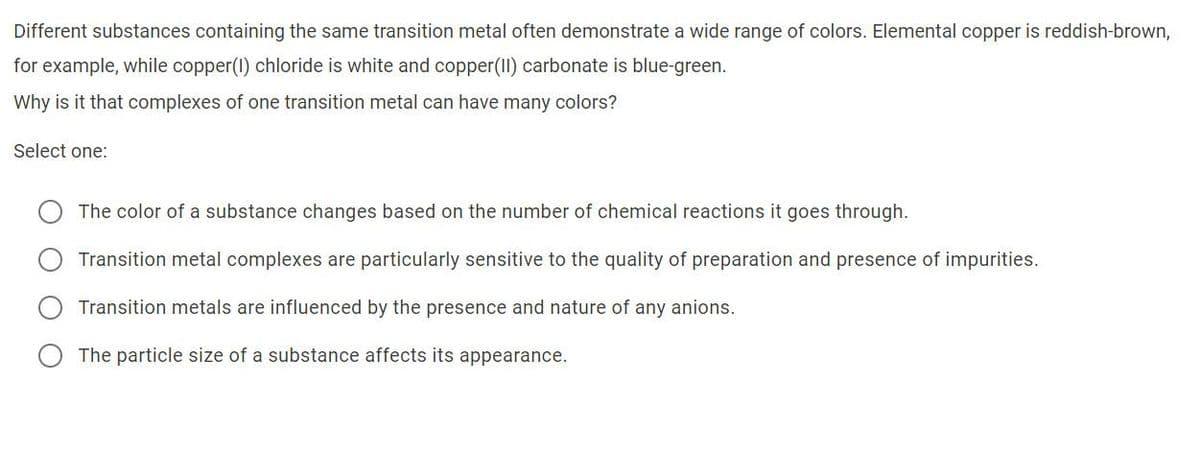Different substances containing the same transition metal often demonstrate a wide range of colors. Elemental copper is reddish-brown, for example, while copper(1) chloride is white and copper(Il) carbonate is blue-green. Why is it that complexes of one transition metal can have many colors? Select one: The color of a substance changes based on the number of chemical reactions it goes through. Transition metal complexes are particularly sensitive to the quality of preparation and presence of impurities. Transition metals are influenced by the presence and nature of any anions. The particle size of a substance affects its appearance.
Different substances containing the same transition metal often demonstrate a wide range of colors. Elemental copper is reddish-brown, for example, while copper(1) chloride is white and copper(Il) carbonate is blue-green. Why is it that complexes of one transition metal can have many colors? Select one: The color of a substance changes based on the number of chemical reactions it goes through. Transition metal complexes are particularly sensitive to the quality of preparation and presence of impurities. Transition metals are influenced by the presence and nature of any anions. The particle size of a substance affects its appearance.
Chemistry: Principles and Practice
3rd Edition
ISBN:9780534420123
Author:Daniel L. Reger, Scott R. Goode, David W. Ball, Edward Mercer
Publisher:Daniel L. Reger, Scott R. Goode, David W. Ball, Edward Mercer
Chapter8: The Periodic Table: Structure And Trends
Section: Chapter Questions
Problem 8.83QE
Related questions
Question
5.

Transcribed Image Text:Different substances containing the same transition metal often demonstrate a wide range of colors. Elemental copper is reddish-brown,
for example, while copper(1) chloride is white and copper(II) carbonate is blue-green.
Why is it that complexes of one transition metal can have many colors?
Select one:
The color of a substance changes based on the number of chemical reactions it goes through.
Transition metal complexes are particularly sensitive to the quality of preparation and presence of impurities.
Transition metals are influenced by the presence and nature of any anions.
The particle size of a substance affects its appearance.
Expert Solution
This question has been solved!
Explore an expertly crafted, step-by-step solution for a thorough understanding of key concepts.
This is a popular solution!
Trending now
This is a popular solution!
Step by step
Solved in 2 steps

Knowledge Booster
Learn more about
Need a deep-dive on the concept behind this application? Look no further. Learn more about this topic, chemistry and related others by exploring similar questions and additional content below.Recommended textbooks for you

Chemistry: Principles and Practice
Chemistry
ISBN:
9780534420123
Author:
Daniel L. Reger, Scott R. Goode, David W. Ball, Edward Mercer
Publisher:
Cengage Learning

Chemistry: The Molecular Science
Chemistry
ISBN:
9781285199047
Author:
John W. Moore, Conrad L. Stanitski
Publisher:
Cengage Learning

Chemistry & Chemical Reactivity
Chemistry
ISBN:
9781337399074
Author:
John C. Kotz, Paul M. Treichel, John Townsend, David Treichel
Publisher:
Cengage Learning

Chemistry: Principles and Practice
Chemistry
ISBN:
9780534420123
Author:
Daniel L. Reger, Scott R. Goode, David W. Ball, Edward Mercer
Publisher:
Cengage Learning

Chemistry: The Molecular Science
Chemistry
ISBN:
9781285199047
Author:
John W. Moore, Conrad L. Stanitski
Publisher:
Cengage Learning

Chemistry & Chemical Reactivity
Chemistry
ISBN:
9781337399074
Author:
John C. Kotz, Paul M. Treichel, John Townsend, David Treichel
Publisher:
Cengage Learning

Chemistry
Chemistry
ISBN:
9781305957404
Author:
Steven S. Zumdahl, Susan A. Zumdahl, Donald J. DeCoste
Publisher:
Cengage Learning


Chemistry for Today: General, Organic, and Bioche…
Chemistry
ISBN:
9781305960060
Author:
Spencer L. Seager, Michael R. Slabaugh, Maren S. Hansen
Publisher:
Cengage Learning